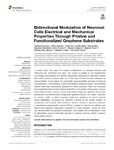Bidirectional Modulation of Neuronal Cells Electrical and Mechanical Properties Through Pristine and Functionalized Graphene Substrates

Use este enlace para citar
http://hdl.handle.net/2183/30619Colecciones
- Investigación (FCIE) [1228]
Metadatos
Mostrar el registro completo del ítemTítulo
Bidirectional Modulation of Neuronal Cells Electrical and Mechanical Properties Through Pristine and Functionalized Graphene SubstratesAutor(es)
Fecha
2022-01-11Cita bibliográfica
Zummo F, Esposito P, Hou H, Wetzl C, Rius G, Tkatchenko R, Guimera A, Godignon P, Prato M, Prats-Alfonso E, Criado A and Scaini D (2022) Bidirectional Modulation of Neuronal Cells Electrical and Mechanical Properties Through Pristine and Functionalized Graphene Substrates. Front. Neurosci. 15:811348. doi: 10.3389/fnins.2021.811348
Resumen
[Abstract] In recent years, the quest for surface modifications to promote neuronal cell interfacing and modulation has risen. This course is justified by the requirements of emerging technological and medical approaches attempting to effectively interact with central nervous system cells, as in the case of brain-machine interfaces or neuroprosthetic. In that regard, the remarkable cytocompatibility and ease of chemical functionalization characterizing surface-immobilized graphene-based nanomaterials (GBNs) make them increasingly appealing for these purposes. Here, we compared the (morpho)mechanical and functional adaptation of rat primary hippocampal neurons when interfaced with surfaces covered with pristine single-layer graphene (pSLG) and phenylacetic acid-functionalized single-layer graphene (fSLG). Our results confirmed the intrinsic ability of glass-supported single-layer graphene to boost neuronal activity highlighting, conversely, the downturn inducible by the surface insertion of phenylacetic acid moieties. fSLG-interfaced neurons showed a significant reduction in spontaneous postsynaptic currents (PSCs), coupled to reduced cell stiffness and altered focal adhesion organization compared to control samples. Overall, we have here demonstrated that graphene substrates, both pristine and functionalized, could be alternatively used to intrinsically promote or depress neuronal activity in primary hippocampal cultures.
Palabras clave
Hippocampal neurons
Graphene
Chemical functionalization
Synaptic activity
Cell stiffness
Graphene
Chemical functionalization
Synaptic activity
Cell stiffness
Versión del editor
Derechos
Atribución 4.0 Internacional
ISSN
1662-453X






